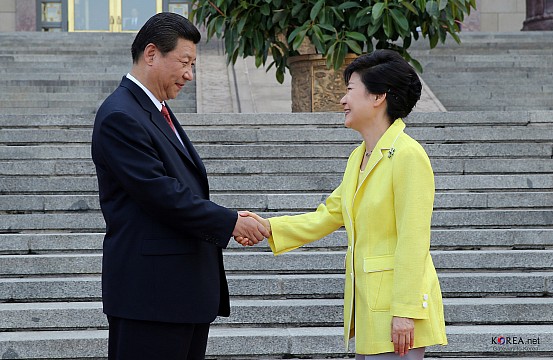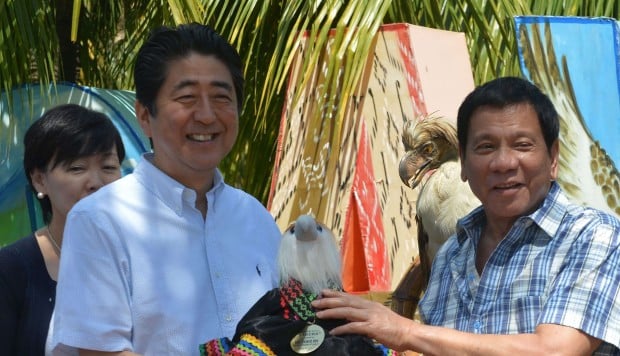 If the 21st century ultimately fulfills its predicted destiny as the “Pacific Century,” future historians will mark 2013 as the watershed year in which the gravity of world power began to tilt toward the Asia-Pacific, and perhaps 2017 as the decisive year of the shift. In 2013, two major economic strategies to strengthen regional cohesion and global connectivity were announced: China’s massive “One Belt, One Road” (OBOR) and South Korea’s “Eurasia Initiative” (EAI). While the former has clearly overshadowed the latter, the relatively tiny South Korea’s aspirations may ultimately hold the key to the success or failure of China’s grand vision because of the pivotal role North Korea plays in the destiny of both countries.
If the 21st century ultimately fulfills its predicted destiny as the “Pacific Century,” future historians will mark 2013 as the watershed year in which the gravity of world power began to tilt toward the Asia-Pacific, and perhaps 2017 as the decisive year of the shift. In 2013, two major economic strategies to strengthen regional cohesion and global connectivity were announced: China’s massive “One Belt, One Road” (OBOR) and South Korea’s “Eurasia Initiative” (EAI). While the former has clearly overshadowed the latter, the relatively tiny South Korea’s aspirations may ultimately hold the key to the success or failure of China’s grand vision because of the pivotal role North Korea plays in the destiny of both countries.
The genesis of both OBOR and the EAI is geography, from which the region’s strategic impetuses flow. As the Western world’s attention has increasingly tilted eastward, manifested in part by the U. S. “Pivot to Asia,” China, in contrast, has turned westward, as well as to its north and south. Not to be outdone, other regional powers have also readjusted their strategic compasses: Russia’s attention is increasingly turning south and east through its “Eastern Dream”; India is turning north and east through its “Act East” strategy; and Japan is turning to its west and south with its “Free and Open Indo-Pacific Strategy.”
These geographic readjustments of strategic priorities are in great part a reaction to the U. S.-centric regional architecture based on the “hub-and-spoke” alliance system that has dominated the region since World War II. OBOR is China’s attempt to build an alternative regional architecture to support its own geopolitical objectives, first and foremost challenging U. S. leadership in the region and ultimately globally. OBOR also serves China’s nearer-term priority of reinforcing its own domestic stability by promoting security in extra-territorial regional neighbors through its economic and political influence.
Through massive investments in infrastructure development projects in geographically strategic countries such as Pakistan, Bangladesh, Myanmar, Cambodia, and countries throughout Central Asia, China offers tempting alternatives to U. S. and Western influence with their more stringent standards and requirements.
Meanwhile, South Korea, whose very existence and security remains firmly entrenched in the U. S. alliance system, is under historically familiar pressure from regional powers vying for influence on the Korean peninsula. President Park Geun-hye’s launch of the EAI was an effort to exert South Korea’s growing strength and to geographically connect Western Europe with the easternmost pillar of Asia, the southern tip of the Korean peninsula.
EAI unambiguously emphasized its political goals to fundamentally alter the geopolitical and security landscape of Northeast Asia. EAI explicitly acknowledges that the single impediment to creating a continuous geographical link between the Atlantic and Pacific oceans through the European and Asian landmasses is the ongoing division of the Korean Peninsula. This vision is in stark contrast to OBOR, whose connections with the West notably stop at China’s eastern borders, glaringly ignoring the Korean Peninsula.
In this regard China’s vision may be more realistic, for it fully accounts for North Korea’s adamant resistance against any regional cooperation, much less loosening of its borders. Indeed, South Korea’s EAI may have been doomed from its inception because its very premise was based on corralling national and regional power to alter North Korean calculations. Unfortunately, North Korean actions in 2016, including its fourth and fifth nuclear tests as well as numerous missile launches, seems to have eliminated any remaining hope in South Korea that North Korea’s leadership is inclined toward a peaceful, much less cooperative future.
Nevertheless, China’s purposefully limited view westward — as well as north and south — with the explicit exclusion of the Korean Peninsula, which is economically and strategically crucial for true regional integration, is striking. It is perhaps further confirmation that for China, maintenance of the status quo — division of the Korean Peninsula — even with North Korea’s ongoing pursuit of nuclear weapons programs, serves Chinese strategic goals: ensuring extra-territorial stability, particularly in its bordering countries.
It is becoming evident that South Korea’s own vision for the region, supported by its growing confidence as a solid middle power, is increasingly at odds with China’s. South Korea’s EAI, despite purporting to share similar goals with OBOR of reviving the ancient Silk Road to promote economic benefits for all involved, is far more likely to be a divergent path than a shared road.
More than the potential loss of long-term regional benefits, however, is the divergence between the two visions for extra-regional integration, which signals a deeper and troubling disparity in fundamental views about regional security. China’s refusal to acknowledge the obstructionist role that North Korea plays, hampering not only regional integration but stability on the Peninsula and beyond, is recognized and challenged by South Korea. Despite the political turmoil surrounding current President Park Geun-hye and her impeachment, and uncertainty about the next leader of the country, it is unlikely that the public will tolerate a return to the permissive engagement of previous Sunshine policies toward the North.
Meanwhile, North Korea’s ability to assert its own independent actions despite regional and global pressures highlights the opportunities for exploitation created by the inability of regional powers to cooperate when national security interests diverge. Thus, the respective grand projects promulgated by China and South Korea to revive the ancient Silk Roads in order to promote regional integration may paradoxically unleash greater divisions in the Asia-Pacific, and fail to deliver the regional stability both nations are striving to achieve.
Finally, uncertainty surrounding the future direction of U. S. policies in Asia under the new Trump administration contributes another element of ambiguity about the regional architecture and whether the United States will remain as the anchor of stability for the region. As such, 2017 may mark the beginning of a 21st century shift in regional and global power, and augurs an unsettling if not certainly eventful future.
© Source: http://thediplomat.com/2017/01/what-south-korea-thinks-of-chinas-belt-and-road/
All rights are reserved and belongs to a source media.
 (NEWSER) – U. S. salmon lovers feeling bad for those overseas infected with a pesky parasite can start worrying about themselves.
(NEWSER) – U. S. salmon lovers feeling bad for those overseas infected with a pesky parasite can start worrying about themselves. 

 Japanese Prime Minister Shinzo Abe, right, and Philippine President Rodrigo Duterte walk together for their meeting at the Malacanang Palace grounds, Thursday, Jan. 12, 2017, in Manila, Philippines. Abe arrived Thursday for a two-day official visit that includes a visit to Duterte’s hometown of Davao city in southern Philippines.(AP Photo/Bullit Marquez)
Japanese Prime Minister Shinzo Abe, right, and Philippine President Rodrigo Duterte walk together for their meeting at the Malacanang Palace grounds, Thursday, Jan. 12, 2017, in Manila, Philippines. Abe arrived Thursday for a two-day official visit that includes a visit to Duterte’s hometown of Davao city in southern Philippines.(AP Photo/Bullit Marquez)
 TOKYO —
TOKYO — 
 With a visit to Philippine President Rodrigo Duterte’s bedroom, having one of the world’s rarest birds named in his honour and guided by a sockless host, Japanese Prime Minister Shinzo Abe had a morning to remember on Friday. Duterte, a charismatic politician known at home for his folksy charm, dropped many of the formal protocols normally associated with visits by a head of government as he took Abe on a tour of his beloved southern home city of Davao. Abe’s day began with a visit to Duterte’s “simple home” for a breakfast of sticky rice cakes and mung bean soup, a presidential aide said, with the leaders dining at a wooden table before heading for a look around Duterte’s house. “We also showed him how the president enjoys the comfort of his own bed, including his old and favourite mosquito net,” Duterte’s aide, Christopher Go, wrote on Facebook alongside a photo of the leaders smiling while standing next to the bed. The leaders later had a casual meeting at a hotel overlooking the sea, where Duterte was photographed in a checkered shirt and long pants but no socks – a familiar look for the 71-year-old who takes pride in his informal fashion style. Abe’s next activity saw him standing in front of a stuffed Philippine eagle, the national bird and one of the world’s most endangered. A ceremony saw a two-year-old eagle named Sakura after the famous Japanese cherry blossom. Abe was given a photo of the eagle, which is kept at a nearby sanctuary, as well as a fluffy toy version draped in indigenous clothing. Abe, normally blue-suited and politically conservative who nevertheless showed off his fun side last year when he ’ closing ceremony, appeared to enjoy the day. He smiled and laughed throughout the eagle ceremony, and ended his Davao trip at a Japanese-language school where he was greeted by singing and flag-waving children. Abe was the first foreign leader to visit the Philippines since Duterte took office just over six months ago. His two-day trip began on Thursday with a much more formal itinerary in the capital of Manila, where he held meetings with Duterte at the presidential palace. Abe was also the first head of government to visit Davao, the largest city in the southern Philippines that is 1,500km from Manila. Duterte, a long-time mayor of Davao before becoming president, has made developing the southern Philippines a top priority, arguing the region has been neglected by “imperial Manila”. Abe flew from Davao to Australia on Friday afternoon as part of a trip that will include Indonesia and Vietnam.
With a visit to Philippine President Rodrigo Duterte’s bedroom, having one of the world’s rarest birds named in his honour and guided by a sockless host, Japanese Prime Minister Shinzo Abe had a morning to remember on Friday. Duterte, a charismatic politician known at home for his folksy charm, dropped many of the formal protocols normally associated with visits by a head of government as he took Abe on a tour of his beloved southern home city of Davao. Abe’s day began with a visit to Duterte’s “simple home” for a breakfast of sticky rice cakes and mung bean soup, a presidential aide said, with the leaders dining at a wooden table before heading for a look around Duterte’s house. “We also showed him how the president enjoys the comfort of his own bed, including his old and favourite mosquito net,” Duterte’s aide, Christopher Go, wrote on Facebook alongside a photo of the leaders smiling while standing next to the bed. The leaders later had a casual meeting at a hotel overlooking the sea, where Duterte was photographed in a checkered shirt and long pants but no socks – a familiar look for the 71-year-old who takes pride in his informal fashion style. Abe’s next activity saw him standing in front of a stuffed Philippine eagle, the national bird and one of the world’s most endangered. A ceremony saw a two-year-old eagle named Sakura after the famous Japanese cherry blossom. Abe was given a photo of the eagle, which is kept at a nearby sanctuary, as well as a fluffy toy version draped in indigenous clothing. Abe, normally blue-suited and politically conservative who nevertheless showed off his fun side last year when he ’ closing ceremony, appeared to enjoy the day. He smiled and laughed throughout the eagle ceremony, and ended his Davao trip at a Japanese-language school where he was greeted by singing and flag-waving children. Abe was the first foreign leader to visit the Philippines since Duterte took office just over six months ago. His two-day trip began on Thursday with a much more formal itinerary in the capital of Manila, where he held meetings with Duterte at the presidential palace. Abe was also the first head of government to visit Davao, the largest city in the southern Philippines that is 1,500km from Manila. Duterte, a long-time mayor of Davao before becoming president, has made developing the southern Philippines a top priority, arguing the region has been neglected by “imperial Manila”. Abe flew from Davao to Australia on Friday afternoon as part of a trip that will include Indonesia and Vietnam.
 MANILA: Japan Prime Minister Shinzo Abe feasted on bean soup and rice cakes at the humble home of Philippine President Rodrigo Duterte on Friday, and sampled the down-to-earth living of a volatile new friend who is shaking up the status quo in Asia.
MANILA: Japan Prime Minister Shinzo Abe feasted on bean soup and rice cakes at the humble home of Philippine President Rodrigo Duterte on Friday, and sampled the down-to-earth living of a volatile new friend who is shaking up the status quo in Asia.
 本格的な入試シーズンの幕開けとなる大学入試センター試験が14日、全国の691会場で始まる。日程は15日までの2日間で、志願者数は前年度より1万2199人多い57万5967人。参加大学の内訳は国立82校、公立86校、私立526校で、国公立大は大学院大を除く全校が利用する。 試験期間中、北日本から西日本までの日本海側を中心に大雪や猛吹雪になるとして、気象庁は警戒を呼び掛けている。大学入試センターも受験生に余裕を持って試験会場に向かうよう呼び掛けたほか、会場の各大学に対し、交通の混乱などがあった場合、試験開始時刻を繰り下げるといった対応を取るよう求めた。
本格的な入試シーズンの幕開けとなる大学入試センター試験が14日、全国の691会場で始まる。日程は15日までの2日間で、志願者数は前年度より1万2199人多い57万5967人。参加大学の内訳は国立82校、公立86校、私立526校で、国公立大は大学院大を除く全校が利用する。 試験期間中、北日本から西日本までの日本海側を中心に大雪や猛吹雪になるとして、気象庁は警戒を呼び掛けている。大学入試センターも受験生に余裕を持って試験会場に向かうよう呼び掛けたほか、会場の各大学に対し、交通の混乱などがあった場合、試験開始時刻を繰り下げるといった対応を取るよう求めた。
 [ワシントン 13日 ロイター] – 米労働省が13日発表した昨年12月の卸売物価指数(PPI、最終需要財向け財・サービス)は、前月比0.3%上昇した。市場予想と一致した。11月は0.4%上昇していた。 前年同月比では1.6%上昇と2014年9月以来、2年3カ月ぶりの大きな伸びとなった。こちらも市場予想と一致した。11月は1.3%の上昇だった。 12月はエネルギー製品の価格が2.6%上昇し、最終需要財の伸びのうち約60パーセントを占めた。エネルギー価格は11月は0.3%の下落だった。 これに伴って最終需要財は12月に0.7%上昇となった。 原油安による押し下げ効果が薄れたことで、卸売物価は上昇しつつある。原油価格は1バレル=50ドルを超える水準で推移しており、12日に発表された輸出入物価統計によると、昨年12月の輸入物価は前年同月比で5年ぶりに近い大きな上昇となった。 ただ、トランプ氏の米大統領選勝利後はドル高が再燃しており、原油値上がりによる物価押し上げ効果は薄まる可能性がある。 12月は食品が0.7%上昇し、11月の0.6%上昇から伸びを拡大した。 ヘルスケア費用は横ばい。11月は0.2%の上昇だった。これらは連邦準備理事会(FRB)が物価の目安として注視する個人消費支出(PCE)物価指数に反映される。 変動の大きい貿易サービスは0.2%上昇。11月は1.3%の大幅上昇だった。貿易サービスは卸売業や小売業の利潤の変化を示す。 変動の大きい食品とエネルギー、貿易サービスを除き、基調的な物価動向を示すとされるコア卸売物価は前月比で0.1%上昇。前年同月比では1.7%上昇だった。11月はそれぞれ0.2%と1.8%の上昇だった。
[ワシントン 13日 ロイター] – 米労働省が13日発表した昨年12月の卸売物価指数(PPI、最終需要財向け財・サービス)は、前月比0.3%上昇した。市場予想と一致した。11月は0.4%上昇していた。 前年同月比では1.6%上昇と2014年9月以来、2年3カ月ぶりの大きな伸びとなった。こちらも市場予想と一致した。11月は1.3%の上昇だった。 12月はエネルギー製品の価格が2.6%上昇し、最終需要財の伸びのうち約60パーセントを占めた。エネルギー価格は11月は0.3%の下落だった。 これに伴って最終需要財は12月に0.7%上昇となった。 原油安による押し下げ効果が薄れたことで、卸売物価は上昇しつつある。原油価格は1バレル=50ドルを超える水準で推移しており、12日に発表された輸出入物価統計によると、昨年12月の輸入物価は前年同月比で5年ぶりに近い大きな上昇となった。 ただ、トランプ氏の米大統領選勝利後はドル高が再燃しており、原油値上がりによる物価押し上げ効果は薄まる可能性がある。 12月は食品が0.7%上昇し、11月の0.6%上昇から伸びを拡大した。 ヘルスケア費用は横ばい。11月は0.2%の上昇だった。これらは連邦準備理事会(FRB)が物価の目安として注視する個人消費支出(PCE)物価指数に反映される。 変動の大きい貿易サービスは0.2%上昇。11月は1.3%の大幅上昇だった。貿易サービスは卸売業や小売業の利潤の変化を示す。 変動の大きい食品とエネルギー、貿易サービスを除き、基調的な物価動向を示すとされるコア卸売物価は前月比で0.1%上昇。前年同月比では1.7%上昇だった。11月はそれぞれ0.2%と1.8%の上昇だった。
 無料通信アプリ「LINE」(ライン)で元交際相手の女性にメッセージを連続して送信したなどとして、北海道警札幌北署は13日、ストーカー規制法違反の疑いで札幌市北区篠路、無職棟方勝己容疑者(51)を逮捕した。容疑を認めているという。
無料通信アプリ「LINE」(ライン)で元交際相手の女性にメッセージを連続して送信したなどとして、北海道警札幌北署は13日、ストーカー規制法違反の疑いで札幌市北区篠路、無職棟方勝己容疑者(51)を逮捕した。容疑を認めているという。 
 If the 21st century ultimately fulfills its predicted destiny as the “Pacific Century,” future historians will mark 2013 as the watershed year in which the gravity of world power began to tilt toward the Asia-Pacific, and perhaps 2017 as the decisive year of the shift. In 2013, two major economic strategies to strengthen regional cohesion and global connectivity were announced: China’s massive “One Belt, One Road” (OBOR) and South Korea’s “Eurasia Initiative” (EAI). While the former has clearly overshadowed the latter, the relatively tiny South Korea’s aspirations may ultimately hold the key to the success or failure of China’s grand vision because of the pivotal role North Korea plays in the destiny of both countries.
If the 21st century ultimately fulfills its predicted destiny as the “Pacific Century,” future historians will mark 2013 as the watershed year in which the gravity of world power began to tilt toward the Asia-Pacific, and perhaps 2017 as the decisive year of the shift. In 2013, two major economic strategies to strengthen regional cohesion and global connectivity were announced: China’s massive “One Belt, One Road” (OBOR) and South Korea’s “Eurasia Initiative” (EAI). While the former has clearly overshadowed the latter, the relatively tiny South Korea’s aspirations may ultimately hold the key to the success or failure of China’s grand vision because of the pivotal role North Korea plays in the destiny of both countries. 
 The Department of Justice (DOJ) on Friday assigned a new prosecutor to take charge of the alleged kidnapping of a South Korean businessman in Angeles City three months ago.
The Department of Justice (DOJ) on Friday assigned a new prosecutor to take charge of the alleged kidnapping of a South Korean businessman in Angeles City three months ago. 

